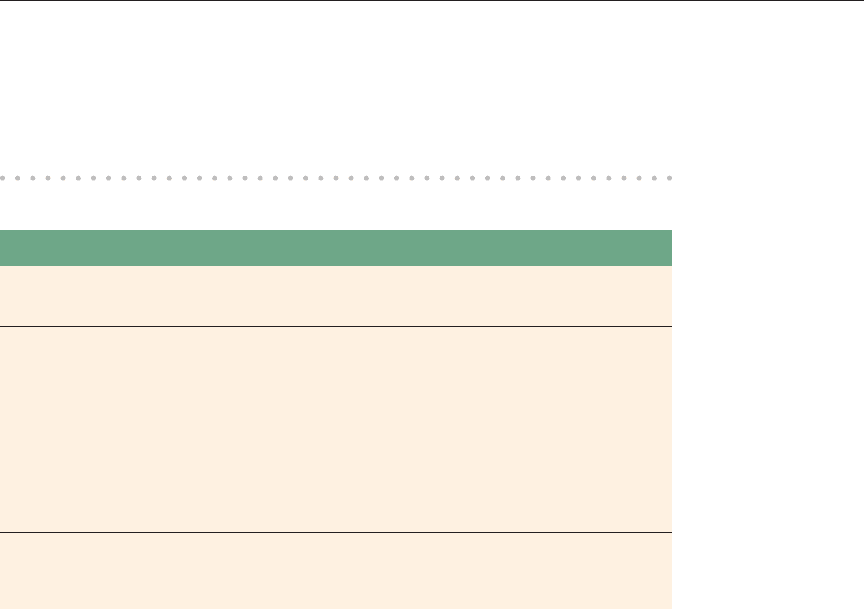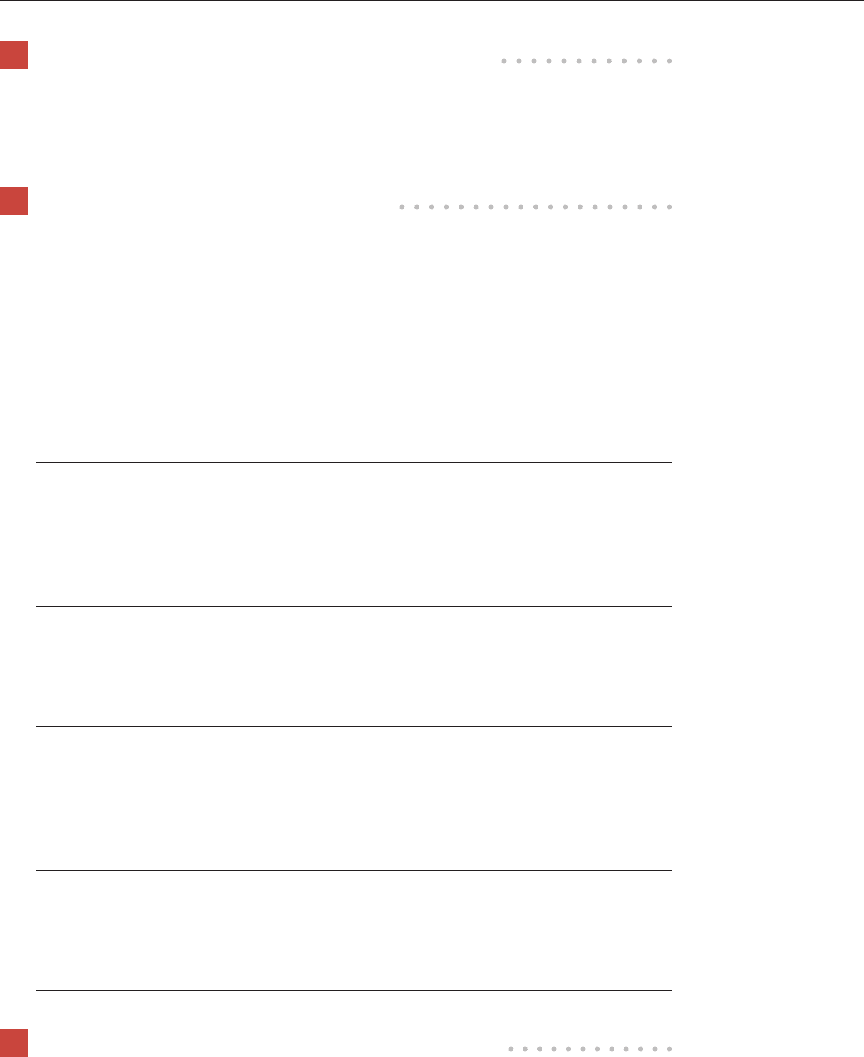Anker Susan. Real Essays with Readings with 2009 MLA Update
Подождите немного. Документ загружается.


WRITING ESSAYS
Chapter 7 • Making a Plan 107
not have steady partners and did not stick around when a female mouse
became pregnant. The mice with hormones in this location were the ones
who ran from commitment. ⻬
Unfortunately, the research did not deal with the most common love
pattern: individuals involved in relationships that last for some time but
not for life. In this pattern, people have a series of serious relationships
that are often broken off when one person wants a formal commitment
and the other doesn’t. Perhaps this research will come next, as it is in
these relationships where much of the pain of love exists. ⻬
Though these behaviors may be built into the brain, scientists are
working on ways to modify the effects. They hope to fi nd a balance so
that love patterns can be modifi ed. One humorous researcher suggested
that before we select our mates, we should ask them to have a brain scan
to determine whether they’re likely to stay or go.
Write Your Own Plan
Before selecting a writing assignment, read how one student, Roberta
Fair, generated an outline on the benefi ts of a college degree. You saw
Roberta’s prewriting on this subject in Chapter 4.
After reviewing her prewriting, Roberta saw that she could group her
ideas about the benefi ts of college into three major points: She could get a
better job, be a better parent to her children, and feel better about herself.
She also used many of her prewriting ideas as supporting details for those
three main points, and she added other ideas that occurred to her.
Roberta decided to organize her ideas by order of importance, build-
ing up to the most important point.
⻬
⻬
ANK_47574_07_ch7_pp100-109 r4 ko.indd 107ANK_47574_07_ch7_pp100-109 r4 ko.indd 107 10/29/08 10:03:42 AM10/29/08 10:03:42 AM

WRITING ESSAYS
108 Part One • How to Read and Write in College
THESIS (part of paragraph 1): Getting a college degree will help me
build a better life for me and my children.
I. Primary support point 1 (paragraph 2): Could get a better job
Supporting details:
A. Get a less boring job
B. Have more options for jobs
C. Make more money and work one job, not two
II. Primary support point 2 (paragraph 3): Be a better parent to
my children
Supporting details:
A. Spend more time with them because I don’t have to work
two jobs
B. Get them some things they want
C. Live in a better place
D. Be a good role model for them
III. Primary support point 3 (paragraph 4): Feel better about
myself
Supporting details:
A. Get respect from others
B. Respect myself because I achieved an important goal
C. Go on to achieve other goals
POSSIBLE POINT FOR CONCLUSION (paragraph 5): Won’t be easy, but
worth the time and effort involved
WRITING ASSIGNMENT
Develop a plan for your essay using the support you wrote in Chapter 6 or one
of the following thesis statements.
Recently, I’ve been very worried about
________________
because
________________
.
I am looking forward to
________________
because
________________
.
My brother/sister has just joined the army, and I am
________________
because
________________
.
ANK_47574_07_ch7_pp100-109 r4 ko.indd 108ANK_47574_07_ch7_pp100-109 r4 ko.indd 108 10/29/08 10:03:42 AM10/29/08 10:03:42 AM

WRITING ESSAYS
Chapter 7 • Making a Plan 109
When I have a confl ict, I usually ________________.
People think I’m a very strong person because ________________.
Before writing, read the following Critical Thinking box.
CRITICAL THINKING: MAKING A PLAN FOR YOUR ESSAY
FOCUS
• Reread your thesis statement and support points.
ASK
• What would be the best way to organize my support points?
(Time? Space? Importance?)
• What point should come fi rst? Next? After that? Last?
• What supporting details will show, explain, or prove each of my
main points?
• Will this organization help me get my main point (my position)
across? Will it help my readers follow my essay?
WRITE
• Write a plan that shows how you want to arrange your points.
ANK_47574_07_ch7_pp100-109 r4 ko.indd 109ANK_47574_07_ch7_pp100-109 r4 ko.indd 109 10/29/08 10:03:42 AM10/29/08 10:03:42 AM

110
You Know This
You often rehearse
in advance.
• Your sports team
plays preseason
games.
• You practice
what you’re
going to say to
someone.
8
Writing a Draft
Putting Your Ideas Together
Understand What a Draft Is
A draft is the fi rst whole version of your ideas in writing. Do the best job
you can in writing a draft, but remember that you will have a chance to
make changes later. Think of your draft as a dress rehearsal for your fi nal
paper.
BASICS OF A GOOD DRAFT
• It has a thesis statement that presents the main point.
• It has primary support points that are stated in topic sentences that
develop or explain the thesis statement.
• It has supporting details that develop or explain each topic sentence.
• It has an introduction that captures the readers’ interest and lets them
know what the essay is about.
• It has a conclusion that reinforces the main point and makes an
observation.
• It follows standard essay form (introduction, body paragraphs,
conclusion) and uses complete sentences.
Practice Writing a Draft
The explanations and practices in this section will prepare you to write a
good draft essay.
■ TEACHING TIP
Suggest to students
that a draft is similar to
a dress rehearsal before
a play or a scrimmage
before a big game. In
addition, require stu-
dents to turn in their
drafts with their fi nal
papers.
■ IDEA JOURNAL
Write about practicing
something important
before you do the
thing itself.
■ For more on thesis
statements, see
Chapter 5. For more
on support, see
Chapter 6.
ANK_47574_08_ch8_pp110-124 r5 aj.indd 110ANK_47574_08_ch8_pp110-124 r5 aj.indd 110 10/29/08 10:04:08 AM10/29/08 10:04:08 AM

WRITING ESSAYS
Chapter 8 • Writing a Draft 111
Draft the Body of the Essay
A good fi rst step in drafting is to refer back to the plan for your essay. The
plan should include your thesis statement, the primary support points for
your thesis, and supporting details for your primary support points.
Referring to the plan, draft complete paragraphs that support your the-
sis. Each should contain a topic sentence that presents a primary support
point as well as supporting details. Usually, your topic sentence should be
either the fi rst or the last sentence in the paragraph. At this point, you’ll be
drafting the body of your essay; you’ll write the introduction and conclu-
sion later. In general, essays have at least three body paragraphs, and they
may have many more, depending on your assignment and purpose.
If you are having trouble with a word or sentence as you draft, make
a note to come back to it and then keep going.
PRACTICE 1 WRITING TOPIC SENTENCES
Writing topic sentences for primary support points is a good way to start draft-
ing the body of an essay. Below is an outline that appeared in Practice 1 of
Chapter 7. Convert each of the primary support points into a topic sentence
that supports the thesis. You can make up details if you’d like.
THESIS STATEMENT: Being a good customer service representative in a re-
tail store requires several important skills.
I. Being pleasant and polite [Primary support point 1]
A. Smiling, saying hello [Supporting detail]
B. Looking at person [Supporting detail]
TOPIC SENTENCE I:
Answers will vary.
II. Listening carefully [Primary support point 2]
A. Making notes [Supporting detail]
B. Asking questions [Supporting detail]
TOPIC SENTENCE II:
III. Figuring out how to solve the problem [Primary support point 3]
A. Calling the right people [Supporting detail]
B. Filling out paperwork [Supporting detail]
TOPIC SENTENCE III:
■ See Chapter 6 for
advice on support and
Chapter 7 for advice
on planning. For a
diagram showing the
parts of an essay, see
page 51, and for a
complete draft of an
essay, see page 122.
ANK_47574_08_ch8_pp110-124 r5 aj.indd 111ANK_47574_08_ch8_pp110-124 r5 aj.indd 111 10/29/08 10:04:08 AM10/29/08 10:04:08 AM

WRITING ESSAYS
112 Part One • How to Read and Write in College
Write an Introduction
The introduction to your essay should capture your readers’ interest and
present the main point. Think of your introductory paragraph as a challenge.
Ask yourself: How can I get my readers to want to continue reading?
BASICS OF A GOOD INTRODUCTION
• It should catch readers’ attention.
• It should present the essay’s thesis statement (narrowed topic + main
point).
• It should give readers an idea of what the essay will cover.
The thesis statement is often either the fi rst or the last sentence in
the introductory paragraph, though you may fi nd essays in which it is
elsewhere.
Here are examples of common kinds of introductions that spark read-
ers’ interest.
Start with a Surprising Fact or Idea
Surprises capture people’s attention. The more unexpected and surprising
something is, the more likely people are to take notice of it and read on.
I was saved from sin when I was going on thirteen. But not really
saved. It happened like this. There was a big revival at my Auntie
Reed’s church. Every night for weeks there had been much preaching,
singing, praying, and shouting, and some very hardened sinners had
been brought to Christ, and the membership of the church had grown
by leaps and bounds. Then just before the revival ended, they held a
special meeting for children, “to bring the young lambs into the fold.”
My aunt spoke of it for days ahead. That night I was escorted to the
front row and placed on the mourners’ bench with all the other young
sinners, who had not yet been brought to Jesus.
— Langston Hughes, “Salvation” (See pp. 745–48 for the full essay.)
Open with a Quotation
A good short quotation can defi nitely get people interested. It must lead
naturally into your main point, however, and not just be stuck there. If you
start with a quotation, make sure that you tell the reader who the speaker
or writer is (unless it is a general quote, like the proverb in the following
excerpt).
■ ESL: Remind non-
native speakers that
it is a convention of
academic English to
present the main point
in the fi rst paragraph,
stated explicitly.
ANK_47574_08_ch8_pp110-124 r5 aj.indd 112ANK_47574_08_ch8_pp110-124 r5 aj.indd 112 10/29/08 10:04:09 AM10/29/08 10:04:09 AM

WRITING ESSAYS
Chapter 8 • Writing a Draft 113
“Grow where you are planted” is an old proverb that is a metaphor for
living. Although I had heard it before, it took me many years to under-
stand and appreciate its meaning. If I had listened to that proverb ear-
lier, I would have saved myself and others many painful experiences.
— Teresa Fiori, “Appreciate What You Have”
Give an Example or Tell a Story
Opening an essay with a brief story or illustration often draws readers in.
Brian Head saw only one way out. On the fi nal day of his life,
during economics class, the fi fteen-year-old stood up and pointed
a semi-automatic handgun at himself. Before he pulled the trigger,
he said his last words: “I can’t take this anymore.”
— Kathleen Vail, “Words That Wound”
(See pp. 759–63 for the full essay.)
Offer a Strong Opinion
The stronger the opinion, the more likely it is that people will pay attention.
Sex sells. This truth is a boon for marketing gurus and the pornogra-
phy industry but a rather unfortunate situation for women. Every issue of
Playboy, every lewd poster, and even the Victoria’s Secret catalog trans-
form real women into ornaments, valued exclusively for their outward
appearance. These publications are responsible for defi ning what is sexy
and reinforce the belief that aesthetic appeal is a woman’s highest virtue.
— Amy L. Beck, “Struggling for Perfection”
(See pp. 829–32 for the full essay.)
Ask a Question
A question needs an answer. If you start your introduction with a ques-
tion, you engage your readers by inviting them to answer it.
If you’re a man, at some point a woman will ask you how she looks.
“How do I look?” she’ll ask.
You must be careful how you answer this question. The best tech-
nique is to form an honest yet sensitive opinion, then collapse on the
fl oor with some kind of fatal seizure. Trust me, this is the easiest way
out. Because you will never come up with the right answer.
— Dave Barry, “The Ugly Truth about Beauty”
(See pp. 817–20 for the full essay.)
■ TEACHING TIP
Have students write
introductions using two
of the techniques. Have
volunteers read them
aloud and discuss how
they catch attention.
ANK_47574_08_ch8_pp110-124 r5 aj.indd 113ANK_47574_08_ch8_pp110-124 r5 aj.indd 113 10/29/08 10:04:09 AM10/29/08 10:04:09 AM

WRITING ESSAYS
114 Part One • How to Read and Write in College
PRACTICE 2 IDENTIFY TYPES OF INTRODUCTIONS
Read the following three paragraphs. Identify the kind of introduction they
use, and write the number in the space to the left of each.
1. surprising fact
2. quotation
3. example or story
4. strong opinion
5. question
1
Several government studies have reported that the number of over-
weight children in the United States has doubled since the 1970s and that
13 to 15 percent of U.S. children are now overweight. The studies cite a
number of causes for this increase; however, the biggest factor is simply
overeating. The average serving at the leading fast-food restaurants has
ballooned with the popularity of “supersize” meals. Many busy families
now eat at these restaurants several times a week because the service is fast
and the meals are a good value. But overindulging consumers — including
children — are paying a severe price in terms of their health, for they face
a higher risk of diabetes, heart disease, and other conditions.
4
The U.S. people must stop wasting the world’s resources. Although
the United States accounts for less than 5 percent of the world’s popula-
tion, it uses 25 percent of the world’s natural resources. One of the worst
examples of waste is the amount of gas we consume. The popularity of
sport utility vehicles (SUVs) has dramatically increased gas consumption.
According to Northeast Environmental Watch, SUVs use 25 percent
more gas per mile than the average car. We also waste vast supplies of
water by using excessive amounts of water while we wash dishes, brush
our teeth, take showers, water lawns, and do other chores. We must stop
our excessive use of limited resources.
5
What does the new business environment mean for college stu-
dents — for your own education and career choices? A fast-changing busi-
ness environment creates fast-growth careers at the same time that it turns
other careers into dead ends. The conventional wisdom holds that the
wisest course is to pick a fi eld that is on the upswing. The conventional
wisdom is right — to a degree. However, in a turbulent environment you
cannot count on stability — especially in growth projections. Today’s hot
careers may soon be dead ends, replaced by tomorrow’s hot careers. This
means that success will come from considering fi rst what you want to do
and what you are good at, and then developing a set of all-purpose job
skills that you can transfer to the next growth area.
— Kenneth H. Blanchard et al., Exploring the World of Business (1996)
ANK_47574_08_ch8_pp110-124 r5 aj.indd 114ANK_47574_08_ch8_pp110-124 r5 aj.indd 114 10/29/08 10:04:09 AM10/29/08 10:04:09 AM

WRITING ESSAYS
Chapter 8 • Writing a Draft 115
PRACTICE 3 IDENTIFY STRONG INTRODUCTIONS
Find a strong introduction in a newspaper, a magazine, a catalog, an adver-
tisement — anything written. Explain, in writing, why you think it is a strong
introduction. Answers will vary.
PRACTICE 4 SELL YOUR MAIN POINT
As you know from watching and reading advertisements, a good writer can
make just about anything sound interesting. For each of the following top-
ics, write an introductory statement using the technique indicated. Make the
statement punchy and intriguing enough to motivate your readers to stay with
you as you explain or defend it.
1. TOPIC: Mandatory drug testing in the workplace
TECHNIQUE: Ask a question.
Answers will vary.
2. TOPIC: Teenage suicide
TECHNIQUE: Present a surprising fact or idea (you can make one up for
this exercise).
3. TOPIC: Free access to music on the Internet
TECHNIQUE: Give a strong opinion.
4. TOPIC: The quality of television shows
TECHNIQUE: Use a quotation (you can make up a good one for this
exercise).
5. TOPIC: Blind dates
TECHNIQUE: Give an example or tell a brief story (you can just sum it up).
PRACTICE 5 ANALYZING WEAK INTRODUCTIONS
Read the following three introductions. Then, indicate whether the introduc-
tions are weak (W) or okay (OK) by writing those letters in the space to the
■ TEAMWORK
Practice 3 works well in
pairs or small groups.
■
TEAMWORK
Practice 4 works well in
pairs or small groups.
Students should be pre-
pared to explain their
choices to the rest of
the class.
ANK_47574_08_ch8_pp110-124 r5 aj.indd 115ANK_47574_08_ch8_pp110-124 r5 aj.indd 115 10/29/08 10:04:09 AM10/29/08 10:04:09 AM

WRITING ESSAYS
116 Part One • How to Read and Write in College
left of each passage. For any introduction that you mark as weak, use the
spaces under it to explain why you think it is weak.
W
In this essay I am going to write about my car. It is not new, but
it is very important to me. It has a good sound system, and I can listen
to music while I drive. Sometimes I open all the windows and turn the
volume and bass way up so it sounds like the band is right there in my
car. Also, it is pretty good on gas, getting 20 mph in city driving. Before I
had a car, I had to take public transportation, which wasn’t very reliable,
so sometimes I was late for class or for work. It took all of the money I
had saved, plus a loan, but my car was worth every penny. It has changed
my life for the better.
Reasons for choices will vary.
OK
We have two good friends, quite dissimilar in most ways, who
share one common characteristic. They have no sense of smell. Paul is an
electrical engineer in his early thirties. Warren is a well-known professor
of psychology some twenty years older. Although you might expect this
condition to be extremely rare, the inability to smell, called “anosmia,” is
relatively common, occurring in about 1 in 500 people.
— Don H. Hockenbury and Sandra E. Hockenbury,
Discovering Psychology, 2nd ed. (2001)
W
“If you can’t change your fate, change your attitude” is a quote by
the writer Amy Tan. Tan is a good writer, and I agree with her. I have a bad
attitude about my job. The place is fi lthy, and we can’t talk to each other.
Write a Conclusion
Your conclusion should have energy and match the force of your thesis
statement; it is your last chance to drive your main point home. Fading
out with a weak conclusion is like slowing down at the end of a race. In
fact, you should give yourself a last push at the end because people usually
remember best what they see, hear, or read last. A good conclusion cre-
ates a sense of completion: It not only brings readers back to where they
started but also shows them how far they have come.
ANK_47574_08_ch8_pp110-124 r5 aj.indd 116ANK_47574_08_ch8_pp110-124 r5 aj.indd 116 10/29/08 10:04:09 AM10/29/08 10:04:09 AM
